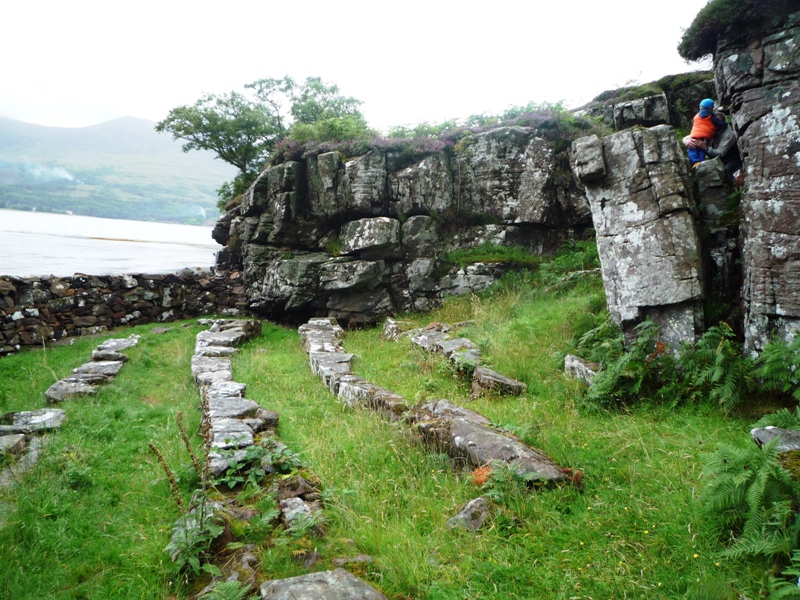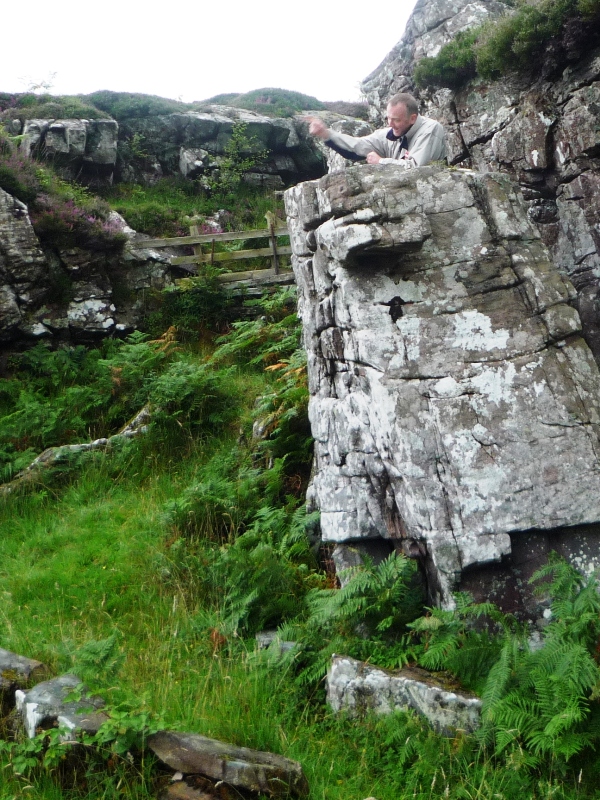Scotland Travel Blog November 2024
“Churchyard Curiosities”
This Blog was prompted by my Sister, who has been delegated the job of generating her Church newsletter. It’s a thankless task, as she has to think up content for something that few people will read, but she feels obliged to do her best.
Knowing that I’m an expert at writing stuff that hardly anyone ever reads, she asked me to write an article about interesting churches in Scotland.
So, this Blog features seven churches in Scotland with something unusual or quirky that makes them stand out.
Kilchoman Church, Islay
Kilchoman Church is not in itself a particularly interesting or attractive building. In fact, it’s a bleak-looking place. Built in 1825, it ceased to be used as a church in 1977 and has since fallen into a state of dilapidation.
So why am I suggesting you’d want to come here?
The interesting aspect of Kilchoman Church originates from a time long before the present church was built. This was the site of a much older church dedicated to Saint Coman, one of the early Irish Missionaries. There are few records about this church, but evidence suggests it dates from the early 14th century and probably replaced an even earlier chapel.
The 14th-century church has gone, but in the graveyard, stands a tall and intricately carved cross from this period. On one side of the cross, the carvings depict the crucifixion. The other side is covered in a beautiful Celtic knot pattern typical of the “Iona School”.
At the foot of the cross, there is a stone plinth with 4 bowl-sized hollows, and in one of the hollows, there is a stone. The stone is part of a local tradition where expectant mothers can leave a gift (usually some money these days), and then turn the stone clockwise to wish for a boy, or anti-clockwise to wish for a girl. That’s what I’ve been told, but it might be the other way round so don’t sue me if you get a different result.
The tradition lives on, and you will still find offerings of coins in the hollows. Several centuries of turning have ground the wishing stone into the shape of an upside-down pear.
Am Ploc,Torridon
At the head of Loch Torridon there is a rocky little peninsula of land (“Ploc” is the Gaelic for a promontory) where you will find square-shaped rocks arranged in rows facing towards a cleft in a rock face. The cleft in the rock forms a neat platform just like a pulpit with a lectern, and that’s exactly what it was used for in the early 1800’s.
To explain how this open-air church came about, I first need to give you a crash course in a period of Scottish religious history known as “The Disruption”. It’s a bit complicated but bear with me.
In 1712, there was an act of parliament passed that was called the “Patronage Act”. This act gave a local landlord the right to choose who the minister would be in their parish. This annoyed a lot of people in Scotland and there was eventually a break-away group of Ministers who set up the “Free Church of Scotland”.
So, a group of ministers didn’t have churches to preach in as these belonged to the ministers appointed by the local landlord. But these ministers had the support of the locals so they set up churches wherever they could.
Am Ploc with its natural amphitheatre shape and convenient rock pulpit was an obvious choice for the people of Torridon. They made it even better by arranging stones as pews and erecting a canvas to give them some shelter from the weather.
We reckon they must have been very devout Christians as the midges at Am Ploc are awful, and sitting still here during a sermon would have felt like a test from God.
Midmar, Aberdeenshire
I’ve written about this place before and I rate it as one of the most interesting religious sites in Scotland. The thing that makes Midmar so fascinating is the fact that the church has a Stone Circle in its graveyard.
It’s quite common in Scotland to find Christian sites built on top of, or next to former Pagan sites. If you were a Christian missionary trying to stamp out Paganism, what could be more symbolic than slapping your church on top of an old ritual site?
Midmar Church is, however, quite unusual in that it has a Neolithic stone circle in its graveyard. The circle is of a style typical to Aberdeenshire and is called a “Recumbent Stone Circle” because it features one large stone laid flat between 2 standing stones. Archaeologists think that the recumbent stone may have been used for ritual cremations and traces of ash were found in the ground around the recumbent stone at nearby Sunhoney Farm.
Of course, we will never know the real purpose of this stone circle, but I like the idea that Midmar is a place where we have said goodbye to loved ones for thousands of years.
Aberlemno, Angus
Aberlemno church also has a standing stone in its graveyard, but this one is relatively modern compared to Midmar’s.
Just in front of Aberlemno Kirk, there is an impressive Pictish Cross carved on a slab of rock that stands around 6.5 feet high and 4 feet wide. On one side. The rock is decorated with elaborate Pictish symbols, and on the other, there appears to be a depiction of a battle with archers and spearmen attacking horsemen.
The battle that the stone commemorates is thought to be a conflict between the Picts and an invading Northumbrian army led by King Ecgfrith. The Picts won the battle decisively so it’s understandable that they’d want to record this event with this outstanding piece of artwork.
Curiously, the stone has a hole drilled through it and no one knows why. It’s too small to fit a hand through, so it’s unlikely to have been part of any ritual. This has led to speculation that it may have simply been done as a pragmatic way of attaching a rope to maneuver the stone into its current location.
Fowlis Wester, Perthshire
Fowlis Wester is a little village just a few miles east of Crieff and a little bit north of the A85 main road from Crieff to Perth. It’s a pretty place, but its location means it doesn’t get many visitors so this feels like a true hidden gem.
Fowlis Wester also has a church with a Pictish stone, but this time the stone has been moved inside the church to protect it. The stone originally stood in the centre of the village and was such a distinctive feature that they decided to replace it with a replica. Not a simple task as it stands over 10 feet tall and is carved with some very unusual Pictish symbols.
The symbology of the stone has baffled historians because it features some symbols that don’t appear on any other Pictish stone and don’t appear to make any Biblical reference. The most puzzling of the symbols is a cow leading a procession of warriors!?.
But there is another Pictish stone at Wester Fowlis Church and this one was only found in 1927 when restoration work was being carried out. The reason the stone remained a hidden secret for so long was because it was built into the wall with a gap left in front of it to protect the fine Celtic carving.
Croick, Sutherland
Go anywhere in the Highlands and you will find evidence of the tragic legacy of the Highland Clearances. Abandoned villages of black houses and fields, that despite years of neglect, still show signs of being worked by farmers who were forced to leave by cruel landlords.
For me, the most poignant reminder of the human cost of the Clearances is found at Croick Church in Strathcarron, to the west of Ardgay.
The Clearances came to this area in 1842. Initially, the tenant farmers of Glencalvie resisted the efforts to evict them from their land, but they were eventually forced off their crofts in May 1845. With nowhere to go, the crofters sought shelter in the graveyard of Croick Church and erected makeshift shelters in its grounds.
Ninety people were camped in the graveyard, but being religious people, they didn’t wish to occupy the church. However, they left a testament to their ordeal by etching their names into the glass window on the east side of the church.
The etchings are still visible but protected behind a perspex sheet, making it difficult to read the details and names recorded in the glass.
Fortingall, Perthshire
The last church I'm including is well-known relative to the places I've mentioned above. Fortingall has several claims to fame, some more credible than others. The claim that is arguably true is that the Yew in its churchyard is the oldest living Yew tree in Europe, and possibly the oldest living organism in Europe.

The Yew tree's age is hard to estimate with precision, but it can safely be said to be over 2000 years old. Sadly, the tree was subjected to some rough treatment by Victorian tourists who used to carve pieces off its trunk as souvenirs. As a result, the tree is now surrounded by a high wall.
The village's more dubious claim is that Pontius Pilate was born here. But if that's true, his Mum must have been on some Roman special ops mission behind enemy lines because the Romans weren't in this part of Scotland at the time Pontius would have been a nipper.
Fortingall can claim to be one of Scotland's prettiest villages and no one would dispute that. The village's "chocolate box" charm is thanks to Sir Donald Currie, who owned the Glen Lyon estate in the late 1800's. Donald felt that Fortingall village was a bit of an eyesore at that time, so he commissioned an architect, James MacLaren, to redesign the village in the "Arts and Crafts" style that was so popular at that time.
The result is a lovely collection of thatch roof cottages clustered around a small hotel that we rate as one of our favourite country inns in Scotland.


.JPG)























